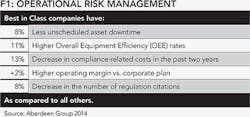Improving offshore operations
It's time to leverage technology to change the dynamic between safety and productivity
Mike Neill, Petrotechnics USA Inc., Houston
Low oil prices, cost cutting, staff reductions, increasing stakeholder expectations, and regulatory pressure - all are common threads weaving through today's dynamic global oil and gas industry. Even with depressed oil prices and reduced drilling capacity, North American crude oil production is expected to increase through 2015. Bullish fever in the Gulf of Mexico is attributed to technology advances that are expected to open exploration into even deeper waters.
To remain competitive, companies are taking a hard look at how they can better manage their operations. What seems to be emerging is that improved ways of managing risk is paramount. In its Operational Risk Management report, industry research analyst Aberdeen Group cited gaining visibility into and control over risk as one of the top priorities of industry leaders today. Best-in-class organizations accept that by proactively managing risk they can improve their production efficiency and reduce costs, which is where they can save in today's challenging business environment.
Technology solutions enable efficiencies and change the game for both onshore and offshore producers. One of the challenges operators face is leveraging value from the operational data and experience they already have collected - albeit spread inconsistently across multiple business functions. They then need to fill the gaps in their understanding about the real state of operations. Organizations are often constrained by the tools and practices they can use to extract practical insight and decision support. Lacking the means to translate data into useful information limits the ability for organizations to use risk as an indicator to support improved, proactive operational decision-making.
Leveraging technology to support operational risk management initiatives offers cost-saving opportunities. Best-in-class companies that leverage technology platforms to manage safety and operations performance are reported to have 8% less unscheduled asset downtime (over those who don't), 8% fewer regulation citations, experience a 13% reduction in compliance-related costs, and realize operating margins 2% or greater than targeted in the corporate plan.
Indeed, there's big opportunity and big value for operators to reduce risk and improve the productivity of their operations, but to achieve this, they need to do things differently.
Aging, gracefully or disgracefully?
As we have seen in mature basin areas in other parts of the world, aging assets introduce a new dimension of risk and impact production. It has been 30 years since we began producing from deepwater in the GoM (>1,000 feet). Many facilities are showing their age, and as such, the challenges will continue to increase for operators to sustain safe and efficient production. Recent incidents have done little to offset these concerns or reduce the level of public scrutiny.
Aging assets expose increased process safety concerns, and new operations are moving into increasingly hazardous, higher risk environments - deeper waters, higher pressures, and temperatures, more extreme climates, and more remote locations. In these circumstances, it is crucial to understand the status of our protective barriers in the context of daily operations if we are to properly manage the associated operational risk.
Process safety principles teach us the importance of designing, building, maintaining, and operating our plants to avoid major accidents. The approach is simple enough that by building multiple layers of protection, such that if one should fail, another will hold, thus avoiding an incident or preventing it from escalating. Accidents resulting in major losses typically occur following the failure of a number of systems or barriers within the process safety management system - all occurring at the same time.
The challenge we face is understanding the impact that can result from the status of our layers of protection, deviations from performance standards in the risk control systems for those layers of protection, and simultaneous operational activities occurring around those layers of protection. It is among the decisions that lead to those interactions that deeper insight and practical support are needed if we are to manage and mitigate operational risk.
Process safety management systems, regulations, and guidelines, including SEMS II, have begun to define standards to mitigate and manage risk, yet there are still unplanned shutdowns, maintenance backlogs, and asset integrity issues associated with poor process safety performance.
It was reported by Marsh and IChemE, at the end of 2013, the property damage cost of poor hydrocarbon process safety topped $34 billion, not including loss of production. This is a sobering reminder of the financial impact associated with process safety related events. Over the years, while we as an industry have improved in the number of incidents, the greatest loss in terms of value has occurred over the past 15 years.
It is interesting to look at the North Sea, a more mature basin area than the Deepwater GoM but similarly facing increasing regulatory challenges."
A 'common currency of risk'
Today's business environment forces operators to be cautious about operations, prudently rationalizing costs without compromising safety. Many organizations find it difficult to decide how to focus operations to achieve the best short-term and long-term results.
Various functional roles within organizations, including operations, maintenance, engineering, EHS, well services, and so on, understandably assert their own functional priorities in order to secure scarce resources (ranging from budget to offshore bed space) in order to meet internal KPIs. This "siloed" approach leads to tensions between departments as different practices and business processes emerge to support individual competing interests. It can also hamper clarity around the true state of assets leading to problems prioritizing operational activities.
Operators are beginning to employ technology solutions to evaluate barrier impairments and operational activities using a "common currency of risk." In this way, the impact of each business function's activities is understood in the context of daily operations. In addition, the interaction between those activities is captured and consistently shared across the organization.
Decisions on operational and maintenance priority can no longer be based on who's shouting the loudest among the various functional business units. Operators need to access tangible indicators and potential risk profiles that clearly identify the cumulative risk to daily operations that could impact the activity plan. By taking all management and risk control systems into consideration, operators can holistically understand, prioritize, and manage business priorities and optimize work execution.
Changing the safety-productivity dynamic
Michael Porter from the Harvard Business School emphasizes, "A company must continually improve its operational effectiveness and actively try to shift the productivity frontier."
Operators continually juggle productivity and safety factors, typically one at the expense of the other. While most operators err on the side of caution, decisions on prioritization are inadvertently made without fully understanding the consequences. Process safety risks may not be so apparent if knowledge and understanding of deviations are not shared or if the existence of an impaired barrier is not identified. Despite the bias of a safe, cautious approach and because there are a number of safety critical systems to manage, it is often considered reasonable to assume that such systems are in good working condition, unless one hears otherwise. As a result, organizations can be caught in the traditional safety-productivity dynamic, driving-up inefficiency as well as operational risk.
Recent regulatory changes from BSEE, in the form of SEMS II, have been designed to help organizations better manage the dynamic between safety and productivity, to improve offshore workplace safety and reduce the frequency and severity of accidents. In addition, regulatory and government sanctions have made getting the dynamic wrong that much more critical.
Using a common currency of risk, productivity and safety demands can move from being antagonistic to complimentary forces that enable safely optimizing operations. When operators have a better understanding of their operational risk, including how people, processes, assets, the environment, reputation, health, and major hazard risk come together, they are able to see the consequence of their decisions, recalibrate if necessary, and accomplish more of the right things, at the right time, in the right way. In this way, they can safely and cost effectively extract the maximum value from an asset and optimize its performance.
By developing a common currency of risk through sophisticated technology frameworks, where activities and priorities are measurable in the context of daily operations, no longer is there a battle between risk management and operations productivity. When the two are harnessed together, safety no longer needs to be set against production. When more work can be done safely and efficiently - and when we can measure and report on how safely and efficiency work was carried out - can we go so far as to say we've reached operations excellence nirvana?
The path towards operational excellence
In a time of falling oil price and cost cutting, looking for operational excellence may be seen as a luxury. But arguably in such economic straits, striving for operational excellence is of even greater importance. If operational excellence is to be more than lip service or a time-consuming initiative, it has to connect factors that contribute to increased operational risk and production inefficiency.
If an operational excellence program has a chance of yielding results, it must be based on a clear understanding of operational risk and the ability to manage that risk. Technology that delivers a common currency of risk by connecting process safety to daily operations can form the basis for a consistent enterprise operational excellence management framework. With such a framework, both offshore and onshore operator executives, leaders, and plant supervisors can:
Rely on a common currency of risk to connect layers of protection from deviations to daily operations by managing enterprise-wide risk; a company can develop a unified picture of performance in the context of daily operations. This improves a decision-maker's ability to manage the potential for risk.
Manage decisions on operational priority with an understanding of the cumulative impact of operational risk on daily operations; Operators can make better decisions throughout the planning-to-execution process. Leadership can help cross-functional teams better prioritize what needs to be addressed to ensure safe, efficient and sustainable operations and better enable the planners to sequence the two-week activity schedule.
Ensure understanding and visibility of operational decisions throughout the planning-to-execution business process. Increased visibility into complex operations at every stage of the planning-to-execution process, whether prioritizing work, optimizing the schedule or executing the plan, enables operators to manage their operational performance. By giving Operations the appropriate tools to understand the risk impact of their decisions, they can better sequence and schedule activities in their two-week plans and get more of the right things done safely.
There's big opportunity and big value - to the tune of billions of dollars - in enterprise-wide operations excellence. In order to compete in today's very dynamic business environment, offshore operators need to do things differently. They need to manage their operational risk in a way that drives safe production efficiency in order to survive.
We started with risk and finished with operational excellence. The two are essentially connected; technology is the means to make the former useful and the latter achievable.
Comprehensive management solutions employing sophisticated operations excellence frameworks are available to help operators reduce their risk and improve the productivity of their operations, mitigate hazards to humans and the environment, improve plant profitability, reduce unplanned downtime in addition to operations and maintenance costs.
It's time to leverage technology to improve offshore operations. It's time to change the dynamic between safety and productivity.
About the authors
Mike Neill is president of Petrotechnics North America. With his background in upstream operations working for BP and throughout his career at Petrotechnics, he has helped improve safety and performance management for oil and gas organizations around the world for more than 30 years. Neill is a member of the CCPS, AIChE, GPA, ASSE, and is an active member of the Mary Kay O'Connor Process Safety Center steering committee.




